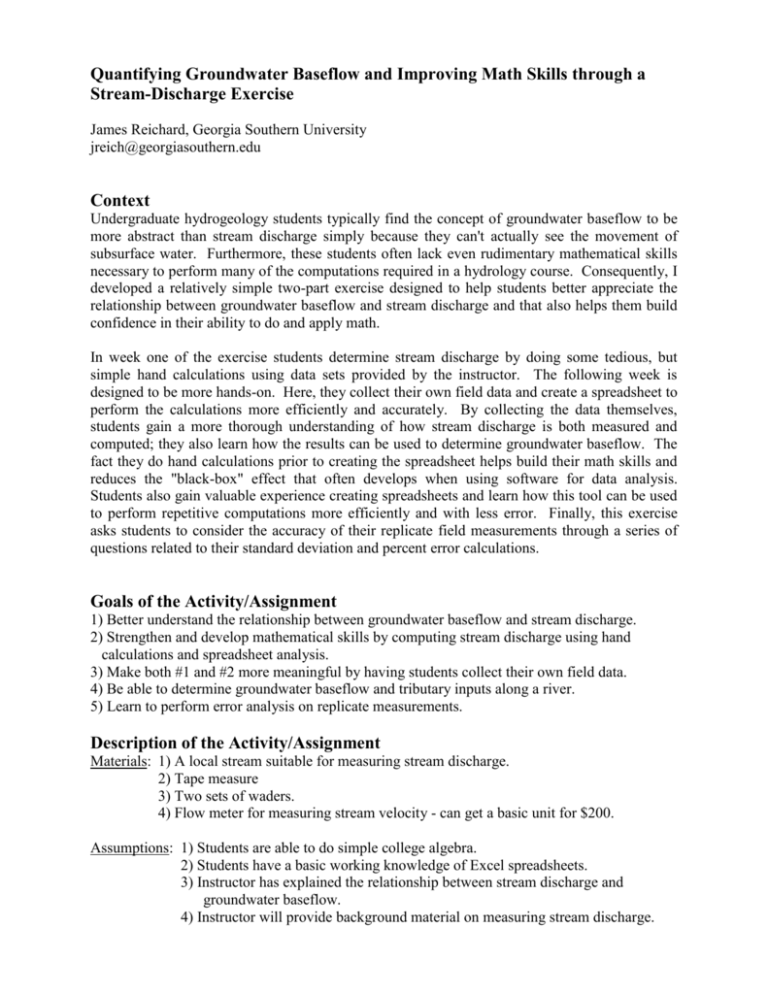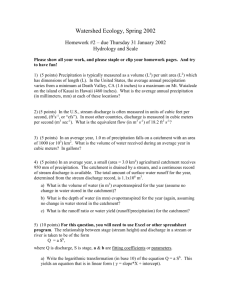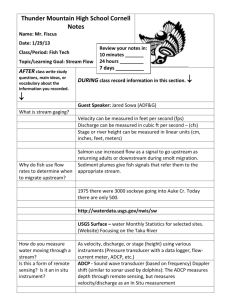ReichardStudent
advertisement

Quantifying Groundwater Baseflow and Improving Math Skills through a Stream-Discharge Exercise James Reichard, Georgia Southern University jreich@georgiasouthern.edu Context Undergraduate hydrogeology students typically find the concept of groundwater baseflow to be more abstract than stream discharge simply because they can't actually see the movement of subsurface water. Furthermore, these students often lack even rudimentary mathematical skills necessary to perform many of the computations required in a hydrology course. Consequently, I developed a relatively simple two-part exercise designed to help students better appreciate the relationship between groundwater baseflow and stream discharge and that also helps them build confidence in their ability to do and apply math. In week one of the exercise students determine stream discharge by doing some tedious, but simple hand calculations using data sets provided by the instructor. The following week is designed to be more hands-on. Here, they collect their own field data and create a spreadsheet to perform the calculations more efficiently and accurately. By collecting the data themselves, students gain a more thorough understanding of how stream discharge is both measured and computed; they also learn how the results can be used to determine groundwater baseflow. The fact they do hand calculations prior to creating the spreadsheet helps build their math skills and reduces the "black-box" effect that often develops when using software for data analysis. Students also gain valuable experience creating spreadsheets and learn how this tool can be used to perform repetitive computations more efficiently and with less error. Finally, this exercise asks students to consider the accuracy of their replicate field measurements through a series of questions related to their standard deviation and percent error calculations. Goals of the Activity/Assignment 1) Better understand the relationship between groundwater baseflow and stream discharge. 2) Strengthen and develop mathematical skills by computing stream discharge using hand calculations and spreadsheet analysis. 3) Make both #1 and #2 more meaningful by having students collect their own field data. 4) Be able to determine groundwater baseflow and tributary inputs along a river. 5) Learn to perform error analysis on replicate measurements. Description of the Activity/Assignment Materials: 1) A local stream suitable for measuring stream discharge. 2) Tape measure 3) Two sets of waders. 4) Flow meter for measuring stream velocity - can get a basic unit for $200. Assumptions: 1) Students are able to do simple college algebra. 2) Students have a basic working knowledge of Excel spreadsheets. 3) Instructor has explained the relationship between stream discharge and groundwater baseflow. 4) Instructor will provide background material on measuring stream discharge. Exercise One - Problem set to be done by hand. 1) The table below contains various stream measurements taken in the field – datum is the stream's water level, so the depths (di) are actually negative numbers. Using the provided graph paper, make a crosssection showing the topography of the stream bed. Remember to: a) Use a SHARP pencil to plot your points - be accurate! b) Draw a smooth curve through the points. c) Be sure your cross-section has the following elements: - title - properly labeled axes - use a vertical scale of 1in = 1ft and a horizontal scale of 1in = 10ft - vertical exaggeration given in the bottom right-hand corner - show your vertical exaggeration calculations in the bottom left-hand corner. 2a) From the distance measurements (bi) determine the section width (wi) for each of the data points in the table. Refer to figure 1 and class notes b) Compute the total stream discharge in ft3/s. Do this by multiplying stream velocity (vi) times the crosssectional area (wi x di) for each stream segment (see figure 1). Then, sum these values to find the total. Table 1 - Stream data measurements. data point ni 0 1 2 3 4 5 6 7 8 9 10 11 12 13 14 15 16 17 18 19 20 21 22 23 24 25 dist from n0 bi (ft) 0.0 2.0 7.0 12.0 17.0 22.0 24.5 27.0 29.5 32.0 37.0 42.0 47.0 52.0 57.0 60.0 63.0 66.0 70.0 75.0 80.0 85.0 90.0 95.0 100.0 105.0 section width wi (ft) ---- depth di (ft) ---0.00 0.91 0.93 1.81 2.67 2.69 2.56 2.54 2.61 2.47 2.47 2.46 2.47 2.59 2.63 2.74 2.68 2.66 2.47 2.48 2.31 1.90 1.81 1.80 0.00 section area Ai (ft2) ---- ave. velocity vi (ft/s) ---0.0 0.90 1.00 1.09 1.21 1.19 1.24 1.46 1.73 2.67 2.51 2.55 2.43 2.41 2.45 2.52 2.45 2.32 2.49 2.37 2.22 2.05 1.89 1.52 0.00 Q total= discharge Qi (ft3/s) ---- Figure 1 - Total stream discharge is computed from field measurements by subdividing the area of flow into small rectangles. The discharge within each rectangle is determined by multiplying the velocity (vi) found at 0.60 total depth (di) by the area (depth (di) times width (wi)). Note that distance (bi) data are used to compute rectangle width (wi). Total discharge is then found by adding up the discharge from all the rectangles using the following relation: n n i 1 i 1 Q total Qi v i a i Figure 2 - Map view showing hypothetical stream discharge measurements at the points indicated. 3) Figure 2 is a map showing a portion of a stream and the location of four (4) discharge values computed using the same method you employed above. a) From this data determine the discharge of each of the tributaries labeled A and B. b) Determine the groundwater baseflow entering the main stream between the two tributaries. 4) Describe a second way in which tributary discharge could be determined. What advantage does the first method have over the second? 5) Describe how you could use stream discharge data to determine total groundwater baseflow for a small watershed. Hint: think in terms of a stream hydrograph and where it should be located - also consider the timing of precipitation events. Exercise Two - Problem set using student-generated field data & spreadsheet. **In this lab you will go into the field and collect your own data to compute stream discharge like done in the previous exercise. However, rather than analyzing the data by hand, this time you will enter all the data into an Excel spreadsheet. Excel will then be used to calculate stream discharge. 1) Compute stream discharge in ft3/s for the same set of data in the previous exercise (table 1) through the use of an Excel file spreadsheet. Follow the steps below in creating your spreadsheet: - Setup a spreadsheet so that it has the same headings as in Table 1. - Enter the field data. - Develop a formula in the spreadsheet for computing section width. There will be two formulas; one for the first and last sections and one for all those in between. This can be tricky as the row numbers in Excel and station numbers (n) will be different. Use the example in figure 1 to help you develop the correct formulas. - Verify that your spreadsheet is working properly by comparing the results with the key provided from the previous exercise. If the results are different, then you need to isolate the problem(s) in the spreadsheet. - Do a "save as" and name the new file "discharge-template.xls". 2) Use your spreadsheet to compute stream discharge from the data you collected in the field. Be sure to make a digital copy of your template file and name it "stream1-discharge". 3) Attached is a set of field data taken at this same site during low-flow conditions. Note that three (3) sets of data were obtained. In this case you are to compute the average discharge using the spreadsheet. Do the following: -Make a digital copy of your template file and name it "stream2-discharge". -Use the copy function to create two (2) additional tables within the same spreadsheet - this will give you three (3) identical tables; -Enter your the sets of field data and compute the individual discharge values. Then determine the average. 4) Now determine the standard deviation and percent error using the following relationships: _ std deviation 2 ( Q i Q) i n 1 %error std deviation Q ave 5) Based on the standard deviation you calculated for the average discharge, how many significant digits do you feel comfortable reporting? Explain why.







